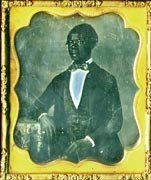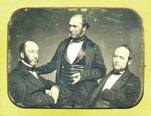|

94.100.1
Portrait of an African American Man, about 1850, Cased, Sixth Plate. Although we do not know this man's name or life story, he appears to be a successful businessman of the 1850s. His well-made suit, immaculate collar, plaid cravat with bow at his neck, and the ring all tell us of his prosperity.

98.95.6
Making A Point, Group Portrait of Men by Mathew B. Brady, about 1850, Cased, Half Plate. Embossed on velvet lining of case: Brady's Gallery 205 & 207 Broadway, N. York & Penn'a Avenue, Washington.
|
|
November 2000
Daguerreotypes from the Collection of
The Henry Ford
The daguerreotype collection of The Henry Ford reflects the museum's interests in everyday life in America. The collection of more than 300 daguerreotypes contains examples by well-known daguerreotypists including Mathew B. Brady and Southworth & Hawes. The images relate to inventions, occupations, portraits of ordinary people and a few rare landscapes.
The Development of Daguerreotype Photography
Practical photography began with the daguerreotype, a process that formed a single image rather than the negative and print that is familiar to us today. We owe the popularity of this process, and ultimately, of photography to a French inventor, Louis Jacques Mandé Daguerre. A landscape diorama painter, he sought a faster method of producing the reality of imagery upon which the diorama's optical effects depended. Louis Daguerre collaborated with Joseph Nicéphore Nièpse for many years before Nièpse's death in 1833. Nièpse, also a Frenchman, experimented with photosensitive chemicals and what today would be called photogravure printing.
By 1839, Daguerre had perfected the direct-positive photographic method and presented the process in detail at a meeting of the Academy of Sciences in Paris, France. Samuel F.B. Morse, the American artist and inventor of the electric telegraph, was in Paris and heard Daguerre's lecture. Morse began making daguerreotypes in the United States by the fall of 1839. The daguerreotype was popular in the United States from 1839 through the 1850s. At its peak in 1853, it is estimated that over three million daguerreotypes were made each year in the United States. By 1860 the development of new photographic processes eclipsed this first popular form of photography.
|

